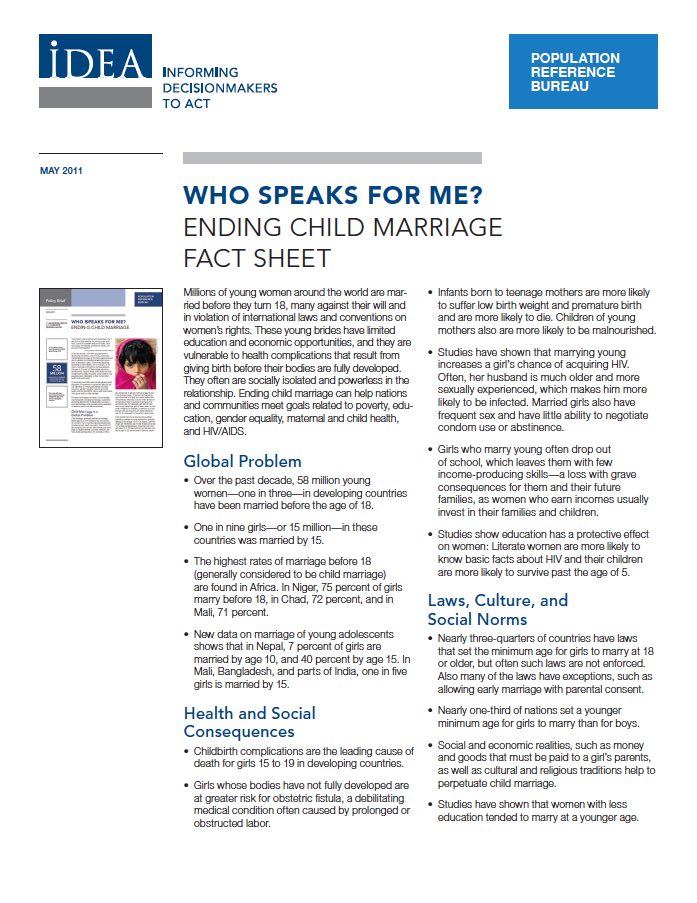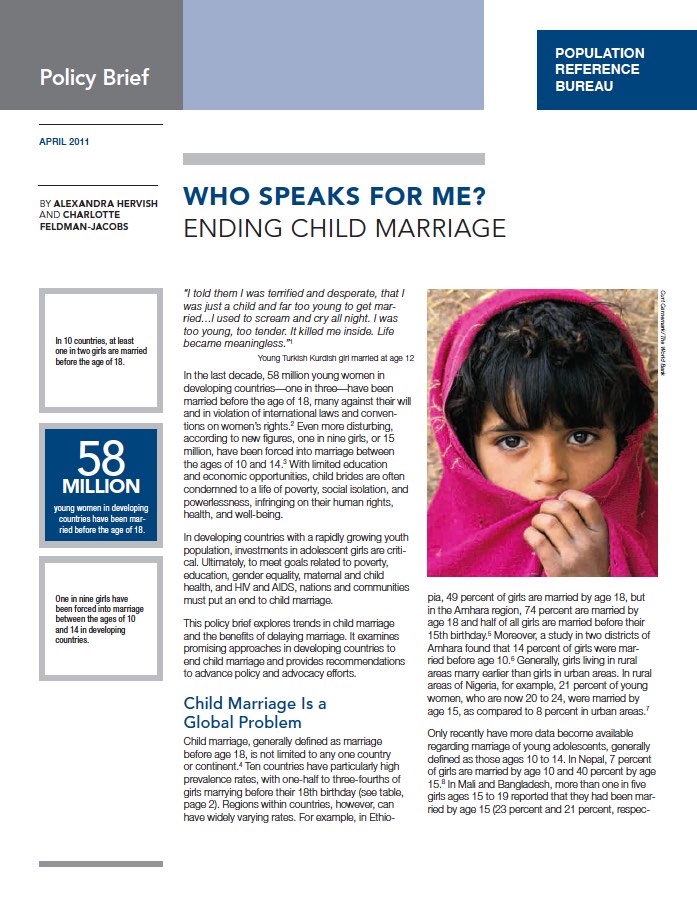
Fact Sheet on Child Marriage
Millions of young women around the world are married before they turn 18, many against their will and in violation of international laws and conventions on women’s rights. These young brides have limited education and economic opportunities, and they are vulnerable to health complications that result from giving birth before their bodies are fully developed. They often are socially isolated and powerless in the relationship. Ending child marriage can help nations and communities meet goals related to poverty, education, gender equality, maternal and child health, and HIV/AIDS.
Global Problem
- Over the past decade, 58 million young women—one in three—in developing countries have been married before the age of 18.
- One in nine girls—or 15 million—in these countries was married by 15.
- The highest rates of marriage before 18 (generally considered to be child marriage) are found in Africa. In Niger, 75 percent of girls marry before 18; in Chad, 72 percent; and in Mali, 71 percent.
- New data on marriage of young adolescents shows that in Nepal, 7 percent of girls are married by age 10, and 40 percent by age 15. In Mali, Bangladesh, and parts of India, one in five girls is married by 15.
Health and Social Consequences
- Childbirth complications are the leading cause of death for girls ages 15 to 19 in developing countries.
- Girls whose bodies have not fully developed are at greater risk for obstetric fistula, a debilitating medical condition often caused by prolonged or obstructed labor.
- Infants born to teenage mothers are more likely to suffer low birth weight and premature birth and are more likely to die. Children of young mothers also are more likely to be malnourished.
- Studies have shown that marrying young increases a girl’s chance of acquiring HIV. Often, her husband is much older and more sexually experienced, which makes him more likely to be infected. Married girls also have frequent sex and have little ability to negotiate condom use or abstinence.
- Girls who marry young often drop out of school, which leaves them with few income-producing skills—a loss with grave consequences for them and their future families, as women who earn incomes usually invest in their families and children.
- Studies show education has a protective effect on women: Literate women are more likely to know basic facts about HIV and their children are more likely to survive past the age of 5.
Laws, Culture, and Social Norms
- Nearly three-quarters of countries have laws that set the minimum age for girls to marry at 18 or older, but often such laws are not enforced. Also many of the laws have exceptions, such as allowing early marriage with parental consent.
- Nearly one-third of nations set a younger minimum age for girls to marry than for boys.
- Social and economic realities, such as money and goods that must be paid to a girl’s parents, and cultural and religious traditions help to perpetuate child marriage.
- Studies have shown that women with less education tend to marry at a younger age.
- A UNICEF study found that Tanzanian women with secondary education were 92 percent less likely to be married before they were 18 than were women who attended only primary school.
Promising Approaches
- In rural Ethiopia, a project targeting young women provided mentoring from adult women in the community, economic incentives to remain in school, and improved access to reproductive health information and services. Early marriage among participants dropped significantly.
- Senegal’s Tostan community empowerment project reduced early marriage through sessions on human rights, democracy, and health that included education on the right to free consent to marriage and the health problems that child marriage and early childbearing can cause.
- In Bangladesh, scholarships for secondary school proved to greatly influence parents’ decisions to keep their daughters in school. The scholarships increased girls’ enrollment and attendance significantly.
- A project in Nepal focused on providing income-generating skills to young girls to help support themselves financially, stay in school, and avoid early marriage.
To request print copies of the PRB policy brief Who Speaks for Me? Ending Child Marriage, contact idea@prb.org.
This policy brief is produced and distributed with support from the U.S. Agency for International Development through the IDEA project. IDEA—Informing DEcisionmakers to Act—increases support among policy audiences for effective health and population programs around the world.

 ">
">
 ">
">